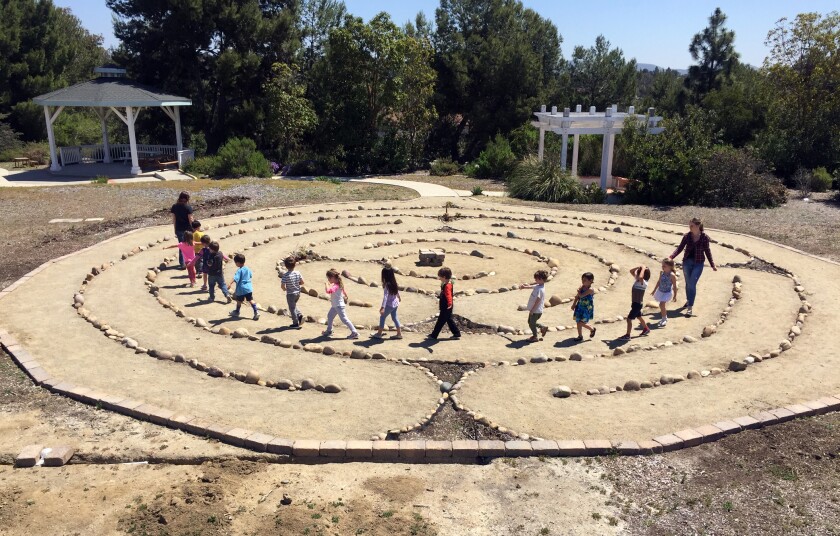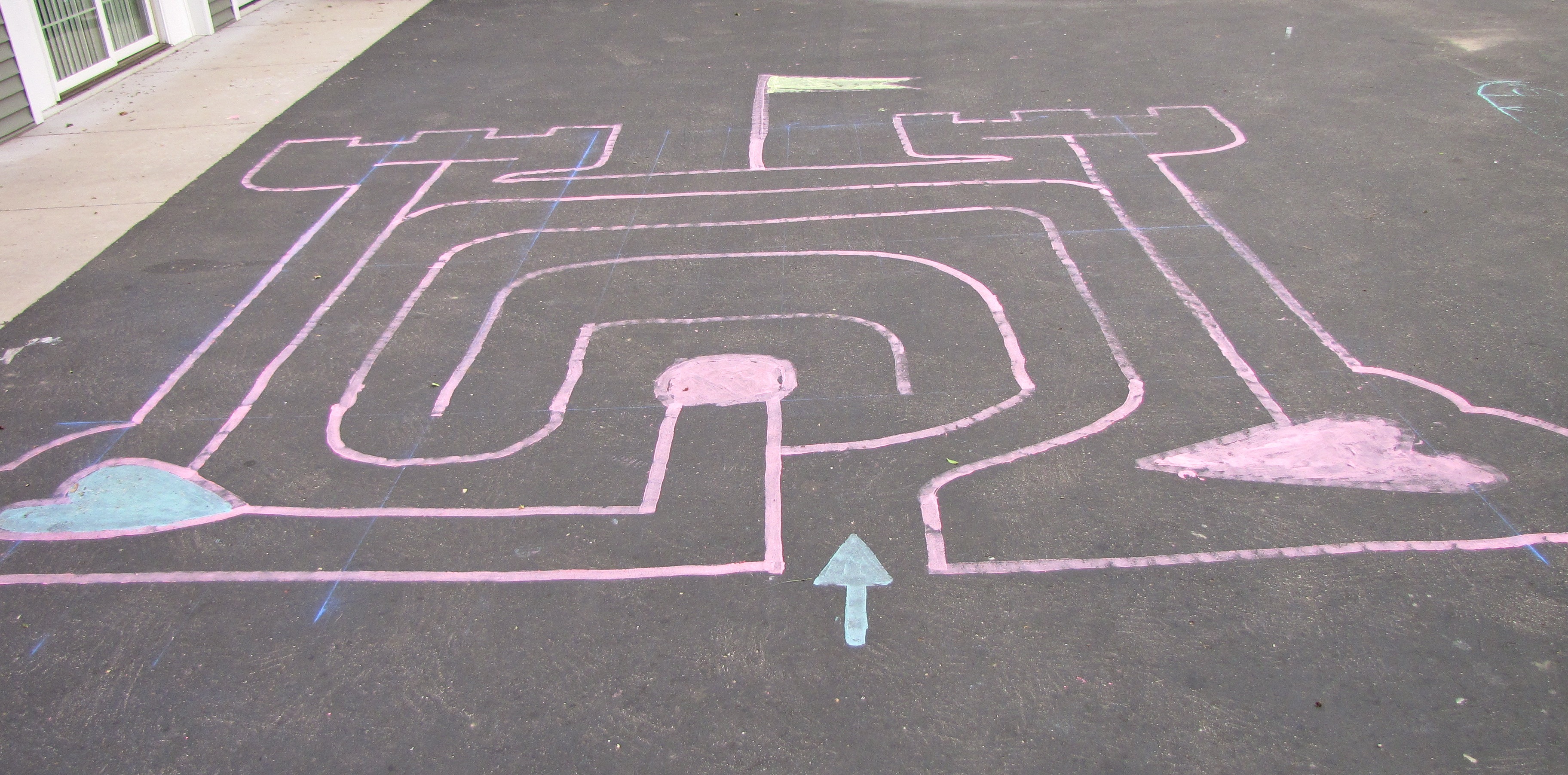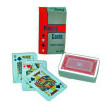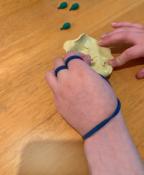What's the difference between a labyrinth vs a maze?
Both labyrinths and mazes have been physically made and used for centuries. The difference is that mazes include dead ends and require switchbacks or back tracking. Labyrinths are one continuous path with no dead ends. You may see corn field mazes or scary mazes around Halloween. They are meant to confuse and challenge. The same is true with mazes on paper. They may be simple or complex, but are designed to include dead ends.
When you see hedges or shrubs designed with walking paths, these are usually labyrinths. They frequently are included in elaborate gardens, especially with older mansions. They are meant for personal reflection. You walk them slowly, while thinking. Hopefully, by the time you are done, you have resolved your issues and calmed your thoughts.
Why build a labyrinth in schools? Why Not!
They can be elaborate or simple. Temporary or permanent. The purpose is self calming and reflection. Sometimes a few minutes quietly walking the path is the sensory break needed. Not all sensory diets need physical exertion.
Explain to students that talking is discouraged because it interrupts "quiet thinking". Save thoughts for after the walk - then remember to make time to share and discuss quietly.
This large one is made from stones. Try a simple one using bean bags or gym cones.
Students can take turns walking the path, or slowly follow each other- but no rushing, crowding or touching, just thinking! repeat as needed.
Use masking or painter's tape - Try to get volunteers to help create it. Maybe older grades can make it for use by younger students.
Make a small one in the the corner of your room. Then ask students to use it as a transition between specials or back to class.
Once you find a size and design that works for your setting, ask if the PTA or other volunteers can paint it on the playground for any student to use at recess or before school begins in the morning. Can't we all could use some "quiet thinking time?
This week's special: Shipping and more! |
Topics
Bilateral motor coordination
ball skills
calming
cooperative games
crossing midline
cutting
dyspraxia
fine motor coordination
gross motor
group activities
handwriting
in-hand manipulation
inside activities
messy play
motor planning
obstacle course
pencil use
preschool
recess
sensory
sensory processing
shoetying
story starters
strengthening
tactile
upper body strength
vestibular; balance
visual motor skills
writing
Labyrinth vs Mazes for sensory diets & more
How to beat the "End of Summer Blues"
The end of summer blues...
So it may not be in the DSM yet, but we all know it exists! Right around labor day or at back-to-school time; it starts slowly; you're not sure what's wrong, you just don't feel like yourself; a little sad; you seem to HATE rainy days a bit more than usual and you seem to constantly crave sunshine and ice cream! Those are the "end of summer blues"! Children and adults may be susceptible to it.
What do to: PLANS seem to help the most. Having something on the calendar to look forward to and anticipate has shown to be helpful. Something DIFFERENT. Here are some examples...
Go Geocaching! It is like treasure hunting! All over the world, regular folks are finding and hiding little containers. Some with treasures and keep-sakes; most just for the fun of the hunt. GPS, like that on your phone is all that is needed. (and good shoes sometimes!) Great fun for adults and children together. Here's a website to get started: https://www.geocaching.com/play
Visit a State or National park and have a picnic. Enjoy the weather and the company. Plan to meet up with friends, family or schoolmates for a pot luck picnic or BBQ.
Movie/TV show binge watching... Catch up on that television show you always mean too or watch a movie and the sequels all in one day!
Back to school BBQ or cookout with games and prizes. Ask for help with planning and preparing to increase anticipation.
Go to a Major or Minor Baseball game. Go early-leave late. Remember the hot dogs and cracker jacks are part of the fun!
Go biking, hiking or rock climbing. (Now-a-days there are many indoor climbing facilities for both kids and kids at heart)
Check out a trampoline park, laser tag or paint ball.
Rent a row-boat or canoe or kayak.
Have a back-to-school sleepover with new classmates.
- Make Sand Castles together!
-Play volleyball, badmitten, bocce, horseshoes, corn hole or frisbee.
- Boardwalk/fair- play games and rides that you usually by-pass. Work together to collect enough tickets to get the silliest prize there is!
- Go to Midnight bowling
- Play miniature golf
- Order a HUGE ice cream sundae that everyone eats at once.

Use a "real" map to navigate to unusual or out of the way destinations. (i.e. "THE" field in Woodstock, NY; Lucy the elephant in NJ; the world's largest Fire hydrant in Tx; Apple Basket in OH; Troll under the bridge in Seattle; etc
Here's a website that lists attractions by state: http://www.worldslargestthings.com/wllist.htm
Visit a Museum: They say there is a museum for everything...from traditional art & science to fun and the unusual. Children's museums usually include many hands-on demo's and exhibits. Don't have kids? Borrow one! Make a bat at Louisville slugger or visit the crayola factory or a nearby cookie factory.
|
Got a minute activity: Fine Motor Scissor Project
Flying Goldfish: 2 snips on a strip of paper, fold and fly! These are made that quickly and are fun to fly!
 Cut a strip from a 8.5"x 11" sheet of paper (more or less - exact measurements not needed, unless ruler work is needed). About 1" in from either end, draw then snip a slit about 1/2 way through the width of he paper on opposite sides of the paper. Bend, tuck and fly! (see diagram).
Cut a strip from a 8.5"x 11" sheet of paper (more or less - exact measurements not needed, unless ruler work is needed). About 1" in from either end, draw then snip a slit about 1/2 way through the width of he paper on opposite sides of the paper. Bend, tuck and fly! (see diagram).
 Cut a strip from a 8.5"x 11" sheet of paper (more or less - exact measurements not needed, unless ruler work is needed). About 1" in from either end, draw then snip a slit about 1/2 way through the width of he paper on opposite sides of the paper. Bend, tuck and fly! (see diagram).
Cut a strip from a 8.5"x 11" sheet of paper (more or less - exact measurements not needed, unless ruler work is needed). About 1" in from either end, draw then snip a slit about 1/2 way through the width of he paper on opposite sides of the paper. Bend, tuck and fly! (see diagram).
1. Mark 2” in from the right edge of the paper, on both the top and bottom. Join these marks making a 2” wide strip down the right side of the paper. (Fig. A)
3. Find the bottom right corner of the paper; measure UP along the right edge of the paper 2 inches. Mark this spot. (Fig. B)
4. At this new mark, draw a 1” horizontal line. (Fig. B)
5. Find the top of the line drawn in step 2. Measure DOWN along this line 2 inches. Mark this spot. Make a 1 inch horizontal line at this mark as you did in step 4, EXCEPT the horizontal line must be drawn to the right of the vertical line being measured (draw into the strip not into the remainder of the paper). Your pattern is now complete. (Fig. B)
6. Decorate.
7. Cut carefully along the long line, making 2 pieces of paper. (The larger piece will not be used for this goldfish, but 3 or more goldfish could be made from this extra piece of paper.) (Fig. C)
8. Very carefully snip the short lines – remember to STOP WHEN THE LINE STOPS!! (Fig. C)
9. Lay the strip onto the table with the decorations face down.
10. Hold both ends of the paper (one in each hand) and bring them together to form a loop. (Fig. D)
11. Interconnect the snips (adjust depth of snips as needed). (Fig. E)
Now your Goldfish is ready to fly. Hold loop with two fingers; one in loop and the other out – Careful not to crush it! Hold up very high, just DROP it -the higher the better (maybe stand on steps) and watch it roll and tumble! (Just let go- do not toss it like an airplane)
^excerpt from Paper Folding toys by Pocket Full of therapy
Got a minute activity: fine motor coordination
Learn and practice the "Jumping Rubber band" trick. Place a rubber band around the index and pointer fingers, close your hand and when opened again the rubber band "jumps" to the ring and little finger. How is it done? While the hand is closed, secretly stretch and slip all of your fingertips, under the stretched band. When you open the fingers again, the rubber band will come off the 1st fingers and go around the last two.
Years ago, famed magician David Cooperfield joined forces with, Julie DeJean, OTR and developed Project Magic. It was a collection of magic tricks and illusions selected for the motor skills and coordination required to complete them. It's goal was to motivate as well as to improve motor skills.
"Most people with disabilities have come to believe that they are less capable than a non-disabled person. Therefore, the ability to perform simple magic allows them to do something that others cannot. Performing magic involves knowing something that the audience does not know - the secret. The performer can work "miracles."This baffles the spectator and creates within the performer a sense of accomplishment, pride, and self-fulfillment.Self-esteem and motivation are essential to the achievement of rehabilitation goals" (https://projectmagic.org)
Got a minute activity: Memory Tic-Tac-Toe
This is a new twist on an old game. Short term memory is challenged by this quick game. So is mental visualization and strategy. Once players get good at it, you can play anywhere; like in the car while traveling, on a school bus or while waiting anywhere. This cognitive challenge may also be helpful as a distraction to reduce anxiety.
This is Memory Tic-Tac-Toe: Draw a traditional playing board, then number 1-9 as demonstrated. Players take turn claiming places by number, mentally keeping track of all spaces played by both players. After someone states they have Tic-tac-toe, ask them to prove it by placing markers on the board. All must agree to the places marked to win the game.
Tips for copying from board, counting, sequencing that can improve efficiency
<![endif]-->

These shortcuts can really save time and energy when learning. Copying from board, groupings, sequencing.
Higher level skills that support other skills ...
We all know that development and skill levels build upon themselves. Easier to more challenging. But sometimes, it is the smallest things that can trip a student up. Things that we are surprised they don't know or do. Here are a few things to take a look at. You may be surprised by what is missing...

Number Dots: Dots representing numbers are always depicted in the same pattern. Recognizing the pattern and knowing it's value instantly is a valuable skill, rather then needing to count the dots each time. The number 5 is always 4 dots in a square with an additional dot in the middle. Domino's, dice, playing cards all use the same patterns.
Number Race Activity: Shake a number of die in your cupped hands (sneak in palmar arch practice!) then spill out. As quickly as possible call out the numbers. These get recorded and the first number to appear 10 times wins.
Play domino's or yatzee! No dot counting allowed!
 
Groupings: Counting any quantity of objects is always easier if split into smaller groups first. If for example, you are counting a stack of papers. You may make bundles of 10, before adding them together. Groupings are especially useful when "counting in your head".
Visual Grouping Activity: Toss a small handful of small objects onto the playing surface. Discuss ways they can be grouped; closest to each other; by color; by shape, etc. Then practice physically making the groups then counting. Next time only physically group 1/2 the objects and try to just visually group the rest. After coming up with a number, check by grouping and counting.
Jig work: Introduction to grouping can begin very early in development. Draw 10 circles on a paper. Ask the client to place one of the given objects on a circle. When all 10 circles are full, transfer them all together into a bag or cup. This also is useful when there are many pieces of a game that must be cleaned up and the client feels overwhelmed and doesn't know where or how to begin.
Play Jacks: Remember this classic game. It forced you to look for groupings to make them easier to pick up. Use pegs and a tennis ball as a substitute for "real jacks".

Copying from the board or a book:
For many students this is one of the most challenging tasks in the day. Practice "remembering" the letters of whole words rather than a letter or 2 at a time. Also approximate where in the sentence you are up to in copying and what the last word copied was. Have eyes try to "jump" or quickly scan to that word instead of needing to start at the beginning each time.

#3 or 5 can go on the #4. An ace or 3 can go on 2.
Sequences and Rapid Fill-in the blank:
Given any number or letter, can they quickly state what comes next or do they need to start at the beginning each time. Being able to "jump in" is more efficient and requires higher level thinking.
Playing Cards: Games like "higher-lower war" are great for this. Each player gets 1/2 the deck. Player 1 turns over his 1st card and places it face up in front of them. Player 2 flips his top card over. If it is the next card higher or lower than player 1's card, it gets placed on that players stack. If it is not, then it goes face up in front of player 2. Continue taking turns until a player is out of cards. They are the winner.
On Special This Week:
Mini Playing cards: 2" glossy finished playing cards. Great size for smaller hands or makes larger hands work harder. Unlimited uses for therapy and play. Small and convenient for travel and therapy bags.
Mini Dice Set: These tiny 1/4" little guys are real dice in mixed colors. So cute and appealing everyone will want to play. You get 24 in a package along with activity ideas. Great for number and color matching, picking up with hand tools or with fingers for in-hand manipulation work. Also develop the arches of the hand as you practice that perfect roll!
Copying From the Board: This activity workbook has a wide variety of graded activities to help children copy accurately and legibly from the board. 112 pages of exercises for improving eye hand coordination, visual & auditory memory, ocular motor skills, figure ground & near-point/far-point copying in both manuscript and cursive writing.This is a truly wonderful resource.
|
The New TurnUnit 3D Balance Trainer (aka Dizzy Disc Senior!)
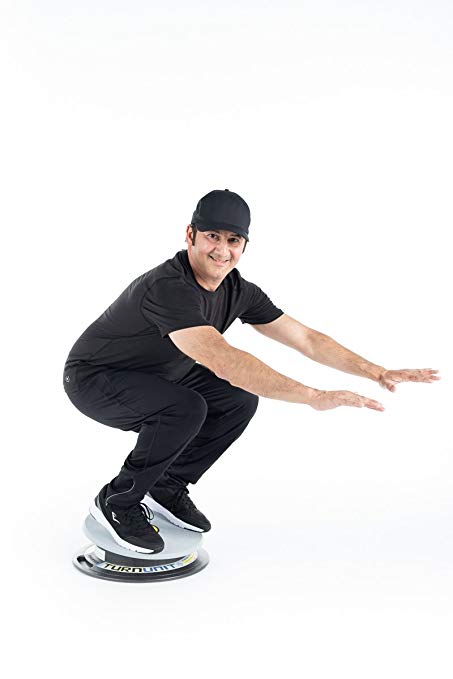
 New design with a 300lb weight limit easily accommodates teens, Tweens and adults ! You know this toy is a "must have" for sensory seekers and others that just gotta spin regardless of age. 16" non-skid platform adjusts angle to challenge balance and change sensory input. Sit, lay or stand (with caution!). Also great for rehab and sports training. Strengthens core too! Here's more info:
New design with a 300lb weight limit easily accommodates teens, Tweens and adults ! You know this toy is a "must have" for sensory seekers and others that just gotta spin regardless of age. 16" non-skid platform adjusts angle to challenge balance and change sensory input. Sit, lay or stand (with caution!). Also great for rehab and sports training. Strengthens core too! Here's more info:
Quick Neuro review...
The Skill of Eating an Ice Cream Cone
The skill of eating an ice cream cone
A handout & home program... |
Improve hand skills with rubber bands!
Doriet Bialer, OTD, MA, OTR has developed a number of hand splint designs using only rubber bands and surgical tape. These splints are quick, temporary, inexpensive and easy to do "on the fly".
Her new manual, "Functional Hand Splints: An Easy DIY" demonstrates step-by-step how to 'twist and turn' a rubber band to improve various grasp patterns, even a dynamic tripod grasp for handwriting. Imagine, walking into a classroom, with just rubber bands and tape, and immediately being able to influence a students skills!
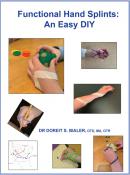 Available as a set with manual and enough materials to get you started, manual only (you have to gather materials) or materials only (refills).
Available as a set with manual and enough materials to get you started, manual only (you have to gather materials) or materials only (refills).Visual Tracking Activities with Touchable Bubbles
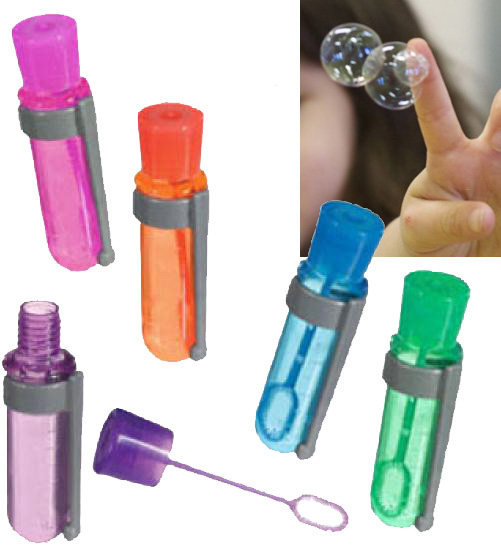 YES! A bubble that doesn't always break when you touch it or when it lands on a surface. Players can REALLY VISUALLY TRACK the bubble then use coordination skills to catch it. Can you make a snowman or catch 5 on a paper? MORE INFO HERE...
YES! A bubble that doesn't always break when you touch it or when it lands on a surface. Players can REALLY VISUALLY TRACK the bubble then use coordination skills to catch it. Can you make a snowman or catch 5 on a paper? MORE INFO HERE...Some things to try:
- Catch a bubble on each finger
- Make a snowman
- How many bubbles can you stack on top of each other?
- Make several dots on a sheet of paper. Then try to catch a bubble on each dot.
- Called out different body parts to catch a bubble on (elbow, thumb, back of hand....)
- Complete a simple path while holding a bubble.
Buying info: Here
Pustefix Bubble Bear - The original premium bubbles with pop-up wand!
 This bear, with the chubby tummy, was the first bubble container with a pop-up wand. Gently squeeze his belly to make the wand appear. Unlike cheap knock-offs, this cutey has a semi-closed inner top that the wand emerges from reducing spills & mess. It also contains PREMIUM bubble juice that produces more consistent bubbles per blow. Nothing is more frustrating than huffing & puffing repeatedly only to get one lone bubble! We even offer bubble juice refills! More info HERE...
This bear, with the chubby tummy, was the first bubble container with a pop-up wand. Gently squeeze his belly to make the wand appear. Unlike cheap knock-offs, this cutey has a semi-closed inner top that the wand emerges from reducing spills & mess. It also contains PREMIUM bubble juice that produces more consistent bubbles per blow. Nothing is more frustrating than huffing & puffing repeatedly only to get one lone bubble! We even offer bubble juice refills! More info HERE...Bubble cups: Oral motor- Respiration, Lip Closure, Blowing without fear!
Bubble cups: a favorite by staff & child
 What's a bubble cup? Take a sturdy cup and make a hole slightly below the upper rim. (The lower on the cup wall the more "huffing & puffing" will be required). Next cut a square (double layered) from a handi-wipe it needs to be about 2" larger than the cup's rim. Secure it over the cup top with a rubber band. Place a straw in the hole you made. Now turn the cup upside down and dunk the handi-wipe top into a bowl of very soapy water. (Avoid getting water into the straw or hole). Players blow through the straw creating long piles of bubbles on top. Since there is no bubble juice actually in the cup, there is no fear of a mouthful of yuck! (Most children learn very quickly to coordinate suck vs blow with this motivating
What's a bubble cup? Take a sturdy cup and make a hole slightly below the upper rim. (The lower on the cup wall the more "huffing & puffing" will be required). Next cut a square (double layered) from a handi-wipe it needs to be about 2" larger than the cup's rim. Secure it over the cup top with a rubber band. Place a straw in the hole you made. Now turn the cup upside down and dunk the handi-wipe top into a bowl of very soapy water. (Avoid getting water into the straw or hole). Players blow through the straw creating long piles of bubbles on top. Since there is no bubble juice actually in the cup, there is no fear of a mouthful of yuck! (Most children learn very quickly to coordinate suck vs blow with this motivating
YES! TOUCH, CATCH, STACK... Finally a bubble that doesn't allows break when you touch it or when it lands on a surface. Players can REALLY VISUALLY TRACK the bubble then use coordination skills to catch it. Can you make a snowman or catch 5 on a paper? MORE INFO HERE...
Activities that address: Suck, Breathe, Swallow - Talk, Listen, Process
Suck, Breathe, Swallow.... Talk, Listen, Process too!
Chances are you've seen "suck, breathe, swallow coordination" in action. Think of an infant drinking a bottle. Many times you'll notice that they stop drinking too take a deep breath. The same is seen when a child is very upset and trying to tell you something while crying. It frequently becomes frustrating for both the child and listener because they are having trouble coordinating it all at once. Remember your Mom telling you not to talk with food in your mouth? Yes, it's impolite, but it also takes requires less coordination and avoids choking or gagging on food while talking.
Let's strengthen oral-motor skills (No, not by talking more! Let's Play!)

Beans 'n Straws:
Use suction through a straw to lift a bean and transfer it to a container. (Make sure that beans will not fit up straw!) Increase the distance to the container to require greater breath control.

Papers 'n Straws:
Similar to bean's, but lightweight, so should be easier. Use different color papers or tissue paper to make a collage or picture as they go.
Let's Race or try it in a Group!
Any of these activities can be done in a group. Give each player a plate or paper towel and ask them to transfer beans or papers from their plate to a neighbor's. Or make teams and do a relay race.

Life Savers on a Stick:
This is an adaption of an old game where players transfer candy pieces from one to another via toothpick... This updated version uses wood skewers (with tips dulled by a nail file). Candy can be carried 10 steps then transferred to a partner or dropped into a container. Sticks must be kept straight out, not up, so gravity can not help. Add more rings for weight. Remind players that they can only hold the stick in their lips. No teeth allowed!
BUBBLES - ALWAYS A FAVORITE!
If you need a reason to do bubbles- Breath Control is it!

Table-top Bubbles:
Begin by getting the table damp. Give each player a thin straw and small cup with bubble juice. (Home made with dish soap is just fine). Dip the end of the straw and blow onto the damp table. Can you do a bubble in a bubble? or a big bubble surrounded by 6 small bubbles? Remember to keep all surfaces and straws damp to keep the bubbles flowing.

Bubble cups: a favorite by staff & child
What's a bubble cup? Take a sturdy cup and make a hole slightly below the upper rim. (The lower on the cup wall the more "huffing & puffing" will be required). Next cut a square (double layered) from a handi-wipe it needs to be about 2" larger than the cup's rim. Secure it over the cup top with a rubber band. Place a straw in the hole you made. Now turn the cup upside down and dunk the handi-wipe top into a bowl of very soapy water. (Avoid getting water into the straw or hole). Players blow through the straw creating long piles of bubbles on top. (Most children learn very quickly to coordinate suck vs blow with this motivating activity!)
Touchable Bubbles (A therapist favorite!)
YES! TOUCH, CATCH, STACK... Finally a bubble that doesn't allows break when you touch it or when it lands on a surface. Players can REALLY VISUALLY TRACK the bubble then use coordination skills to catch it. Can you make a snowman or catch 5 on a paper? MORE INFO HERE...
Pustefix Bubble Bear - The original premium bubbles with pop-up wand!
This bear, with the chubby tummy, was the first bubble container with a pop-up wand. Gently squeeze his belly to make the wand appear. Unlike cheap knock-offs, this cutey has a semi-closed inner top that the wand emerges from reducing spills & mess. It also contains PREMIUM bubble juice that produces more consistent bubbles per blow. Nothing is more frustrating than huffing & puffing repeatedly only to get one lone bubble! We even offer bubble juice refills! More info HERE...
|
Subscribe to:
Posts (Atom)

